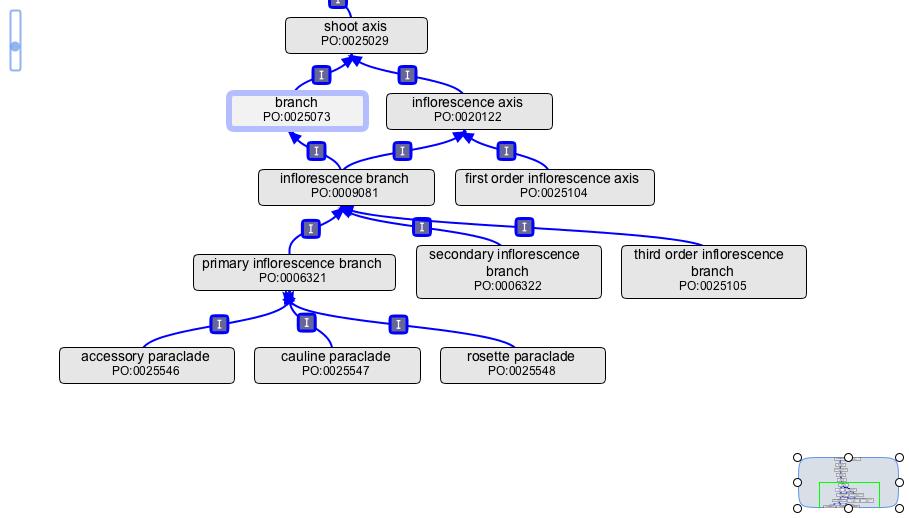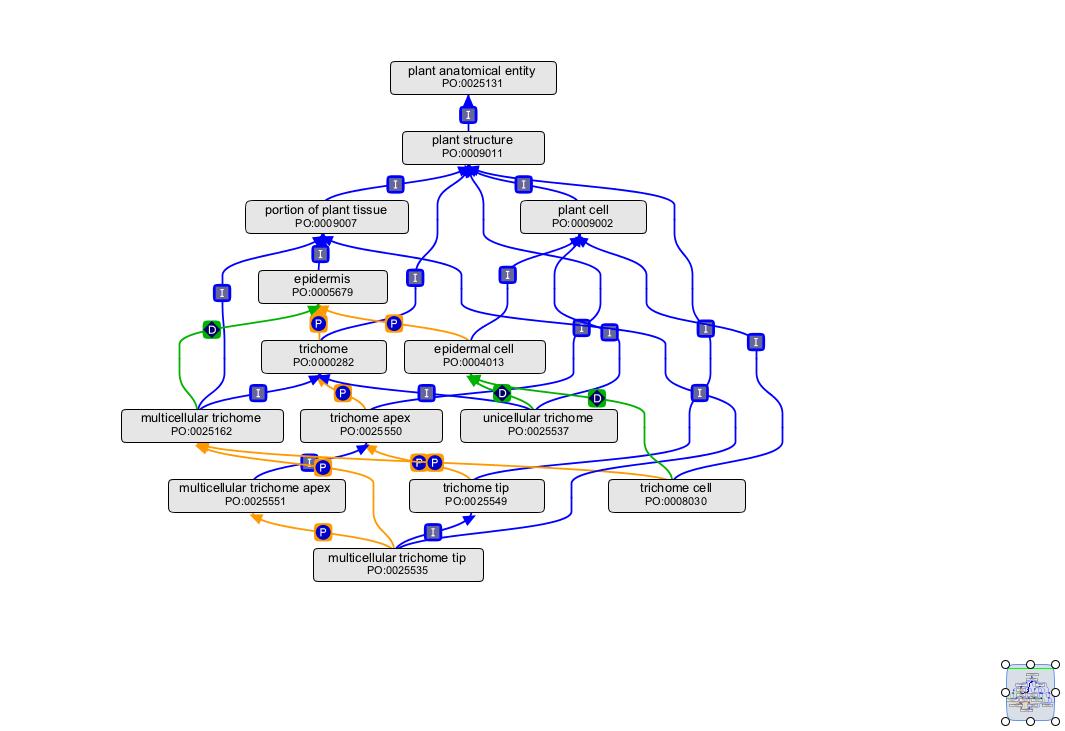Difference between revisions of "POC Conf. Call 4-23-13"
| Line 53: | Line 53: | ||
see this paper for additional information http://aob.oxfordjournals.org/content/early/2011/03/01/aob.mcr039.full | see this paper for additional information http://aob.oxfordjournals.org/content/early/2011/03/01/aob.mcr039.full | ||
| − | + | =[https://sourceforge.net/tracker/?func=detail&aid=3610120&group_id=76834&atid=835555 trichome tip and apex]= | |
Based on the discussion on POC call 4-16-13, make new terms and extensively revised the trichome branch of the ontology: | Based on the discussion on POC call 4-16-13, make new terms and extensively revised the trichome branch of the ontology: | ||
Revision as of 22:06, 22 April 2013
POC meeting, Webex Conference Call; Date: Tuesday April 23rd, 2013 10am PST/1pm EST
In attendance:
Absent:
Other Items
Chelsea Specht (http://spechtlab.berkeley.edu/) will be visiting OSU to give the Templeton Lecture. Her talk is entitled: "Petaloidy, polarity, and pollination: the evolution and diversification of floral form in the Zingiberales."
She will be on campus all day Thursday(4/25) and Friday morning (4/26). Should we plan to meet with her?
accessary paraclade etc
Request from JL for the Plant Phenotype project for the term 'accessory branch' or accessory paraclade:
Suggested term and def'n: accessory branch (new PO:ID): A shoot axis (PO:00025029) that develops from a shoot node (PO:0005004) that has produced at least one axillary branch (PO:0006343)
Literature citation: The term 'accessory branch' is used in the description of the different types of phytomers (pg. 2724, top of left column):
"...In both of these phytomer types, a second branch (accessory branch) may later develop between the axillary branch and its subtending leaf (Fig. 1A)." Talbert et al, 1995
This figure is actually referring to an accessory paraclade, not simply an accessory branch.
We had an extensive discussion last week, so to help clarify things I took the figure from last week and labelled it with the new terms
Annotated figure:
Changes that were made to the inflorescence branch terms
* primary inflorescence branch (PO:0006321): An inflorescence branch (PO:0009081) arising from a first order inflorescence axis (PO:0025104). was 'second order inflorescence axis' - swapped name and exact synonym and removed the related synonym: second order inflorescence branch as it was inconsistent.
* second order inflorescence branch (PO:0006322)- An inflorescence branch (PO:0009081) arising from a primary inflorescence branch (PO:0006321). (was third order inflorescence axis). Added exact synonyms: second order paraclade, secondary inflorescence branch, third order inflorescence axis, Removed the related synonym: second order inflorescence branch as it was inconsistent.
* third order inflorescence branch (PO:0025105): An inflorescence branch (PO:0009081) arising from a secondary inflorescence branch (PO:0006322). (was fourth order third order inflorescence axis (PO:0025105).
Added exact synonyms: third order paraclade, third order inflorescence branch, fourth order inflorescence axis, tertiary inflorescence branch
Please see https://sourceforge.net/tracker/index.php?func=detail&aid=3609161&group_id=76834&atid=835555 for details about the paraclade terms
see this paper for additional information http://aob.oxfordjournals.org/content/early/2011/03/01/aob.mcr039.full
trichome tip and apex
Based on the discussion on POC call 4-16-13, make new terms and extensively revised the trichome branch of the ontology:
Added unicellular trichome, rather than having it a synonym of trichome cell.
Added new terms and revised the rest:
* multicellular trichome (PO:0025162): A portion of plant tissue that forms a non-sclerified outgrowth from the epidermis. [source: POC:curators]
* unicellular trichome (PO:0025537):- A trichome (PO:0000282) that is a single plant cell (PO:0009002). is_a trichome, is_a plant cell. comment: This should not be confused with a trichome cell, which is a plant cell (PO:0009002) that is part of a multicellular trichome (PO:0000282).
* trichome apex (new PO:0025550): A plant structure (PO:0009011) that is the apical most portion of a trichome (PO:0000282). comment: An apex of a unicellular trichome is a GO sub-cellular component GO:xxxxxxx. is_a plant structure, part_of trichome ** multicellular trichome apex (new PO:0025551): A portion of plant tissue (PO:0009007) that is the apical most portion of a multicellular trichome (PO:0025162). is_a trichome apex, part_of multicellular trichome (PO:0025551)
* trichome tip (new PO:0025549): A plant structure (PO:0009011) that is the apical most portion of trichome apex (PO:0025550). is_a plant structure, part of trichome apex ** multicellular trichome tip (PO:0025535): comment:
Will request the parts of the unicellular trichome from GO
petal nanoridges
Suggested Definition: Microscopic, often parallel, ridges composed of cutin occurring on the surface of petals. Parent/relationship: part_of petal epidermis (PO:0006041)
Reference: PMID 19959665
Added new term: plant cuticle ridge (PO:0025536): A portion of plant cuticle (PO:000022) that forms a ridge, may be overlayed with epicuticluar wax (PO:0025388).
epicuticular wax (PO:0025388): A portion of cuticular wax that forms crystalloids or a smooth film on the exterior of a cuticle. [source: PMID:12467640, PO_Ref:00010]
Comment: Epicuticular waxes may take a variety of forms, such as plates, ribbons, tubes, and rods.
Image annotations
Update on the progress on the image annotations:
- New dropbox has been set up for the Po-Images
- DWS has original images (higher res), sending 2 copies, labelled and unlabelled (lower res versions), needs help converting the pdfs into tab-delimited files
- DWS is providing the data for ~3 dozen images (tab delimited file), will be incorporated into the new database
- Sample images from DWS, NYBG (~2 dozen) can be used as a test set for segmenting and labeling with PO terms
- AISO to segment and label images with PO terms
- Data submission template for bulk uploads for whole images with keywords
- import script for whole images, can be used for any images with keyword associations, pull in stuff from Plantsystematics.org
- first whole images, then segmented ones
- image annotation tool, keywords, uses tab delimited file
- database and schema has been built to hold the whole images and the parts, along with the keyword annotations
- Need to prioritize which terms need images: PJ: Physco terms, grass florets, root anatomy, SAM (fern and flowering plant), different kinds of veins in leaves, part of ATOL project
- DWS has images of thorns and prickles, septum, locule, pericarp,
-DWS wants LC to look at the spreadsheet??
Other Items for discussion
- please see the Items_for_future_meetings page, will be moved here before the meeting
Upcoming meetings and Presentations 2013:
NCBO Hackathon April 29-30, 2013
The NCBO Hackathon will take place at Stanford University on April 29-30, 2013. This event will focus on projects in biomedical or clinical informatics that can benefit from use of ontology-based technology.
The entire NCBO Team will be available to brainstorm application ideas and to answer development questions. We will also have separate sessions to provide training on the NCBO Web services, the BioPortal SPARQL endpoint, and other topics of interest requested by participants.
If you are thinking of incorporating semantics into your software application, the Hackathon will provide a great opportunity to get a head start on your project.
Phenotype RCN Plant Group Meeting- Ames, Iowa April 30th-May 3rd
We will be meeting to work on the Plant Phenotype Pilot Project, LC is going
PR-PO-GO meeting, May 15-16th 2013
Please see this page for more information: PRO-PO-GO_Meeting
Location: Buffalo, NY
Dates: May 15-16th, 2013.
- 1. To inform members of the Protein, Plant, Gene Ontology communities of developments in each of these ontologies, and in related ontologies such as the CL (Cell), TO (Plant Trait), ENVO (Environment), PATO (Phenotype) and IDO-Plant (Plant Infectious Disease) ontologies. Specifically:
- a. To enhance the PO treatment of plant-related proteins
- b. To address issues concerning reuse of GO terms to describe plant-related proteins, for example as concerns treatment of plant life cycle and development stages
- 2. To contribute to the cROP (Common Reference Ontologies for Plants) initiative
- 3. To contribute to the ontological understanding of phenotype and disease in all model organisms.
- 4. To identify potentially fruitful applications which enhanced ontology coordination might bring.
1st International Workshop on Semantics for Biodiversity (S4BIODIV), Montpellier, 26-30 May 2013
Registration Information ESWC 2013
Early Registration deadline March 17th
Agropolis Montpellier, the University of Montpellier and Bioversity are collaborating to organize a one-day workshop entitled 'Agrobiodiversity semantics' as part of the larger conference.
Held in parallel with the 10th Extended Semantic Web Conference (ESWC 2013)
Workshop date: May 27, 2013
MONOCOTS V Meeting at NYBG, July 5th - 14th, 2013
5th International Conference on Comparative Biology of Monocotyledons Friday, July 05, 2013 7:00 AM - Sunday, July 14, 2013 12:00 PM (Eastern Time)
The New York Botanical Garden & Fordham University
ICBO 2013, Concordia University, Montreal, Quebec July 7th - 9th 2013
4th International Conference on Biomedical Ontologies 2013 (ICBO2013)
Concordia University, Montreal, Quebec, July 7th - 9th 2013 call for papers
The conference aim is to foster discussion, exchange, and innovation in research and development in the areas Biomedical Ontology. Researchers and professionals from biology, medicine, computer science and engineering are invited to share their knowledge and experience.
The event is part of the Semantic Trilogy 2013 featuring:
- International Conference on Biomedical Ontologies (ICBO 2013)
- Canadian Semantic Web Symposium (CSWS 2013)
- Data Integration in the Life Sciences (DILS 2013)
Workshop on Semantic Systems Biology 2013 (SSB2013) will be held as part of the International Conference on Biomedical Ontologies (ICBO2013) at Concordia University, Montreal, Quebec, on July 7th, 2013. The event is part of the Semantic Trilogy 2013 (above)
Topics of interest include, but are not limited to:
- ontologies & terminologies for modeling computational biology
- ontologies & terminologies for simulation (and result data) in computational biology/medicine/neuroscience
- semantic web technologies for description, integration, query and discovery of models, simulations and result data
- semantic web technologies for biological data and analysis
- semantic annotations of bio-models
- applications of ontologies in computational systems biology/medicine/neuroscience
- semantic platforms for undertaking and visualizing simulation results
We welcome four types of submissions:
- short papers, up to 4 pages.
- long papers, up to 7 pages.
- position papers, up to 1 page.
- late breaking reports, up to 1 page.
See the ICBO website for further information on the submission types.
All submission are due on Monday, April 15 2013. Notification of acceptance: May 6th, 2013
Botanical Society Meeting July 27-31st New Orleans
- MAG is planning to present the work she has been doing with the images and slides, will circulate the abstract


